Gerard Houckgeest
- born c. 1600–died August 1661
- active in Delft from 1635 to 1649
Gerard Houckgeest is thought to have been born in The Hague, where he learned to paint from Bartholomeus van Bassen (1590–1652). He worked in The Hague, Delft, Steenbergen, and Bergen op Zoom. He may have spent some time in England as well. Charles I owned at least five paintings, known as 'Perspectives,' which principally focused on perspective in landscapes or interiors of churches or homes, and were painted entirely or partly by Houckgeest.

Bartholomeus van Bassen
Between 1618 and 1620
Oil on panel, 57.5 x 87 cm.
North Carolina Museum of Art, Raleigh NC
Houckgeest initially specialized in painting imaginary church interiors and ornate Renaissance buildings (fig. 1) rendered in somber browns and reds, which bear little resemblance to his revolutionary works painted in Delft. The reasons for Houckgeest's sudden evolution have intrigued art historians, but adequate explanations remain elusive. The contrast in style between the first works and those painted in Delft is so great that it appears unlikely that his style shifted without some external influence.Arthur K. Wheelock Jr., "Gerard Houckgeest and Emanuel de Witte: Architectural Painting in Delft around 1650," Simiolus: Netherlands Quarterly for the History of Art, vol. 8, no. 3 (1975–1976): 170. The works of Pieter Saenredam, Carel Fabritius, Emanuel de Witte and Hendrick van Vliet have all been mentioned as possible springboards for Houckgeest's new style.
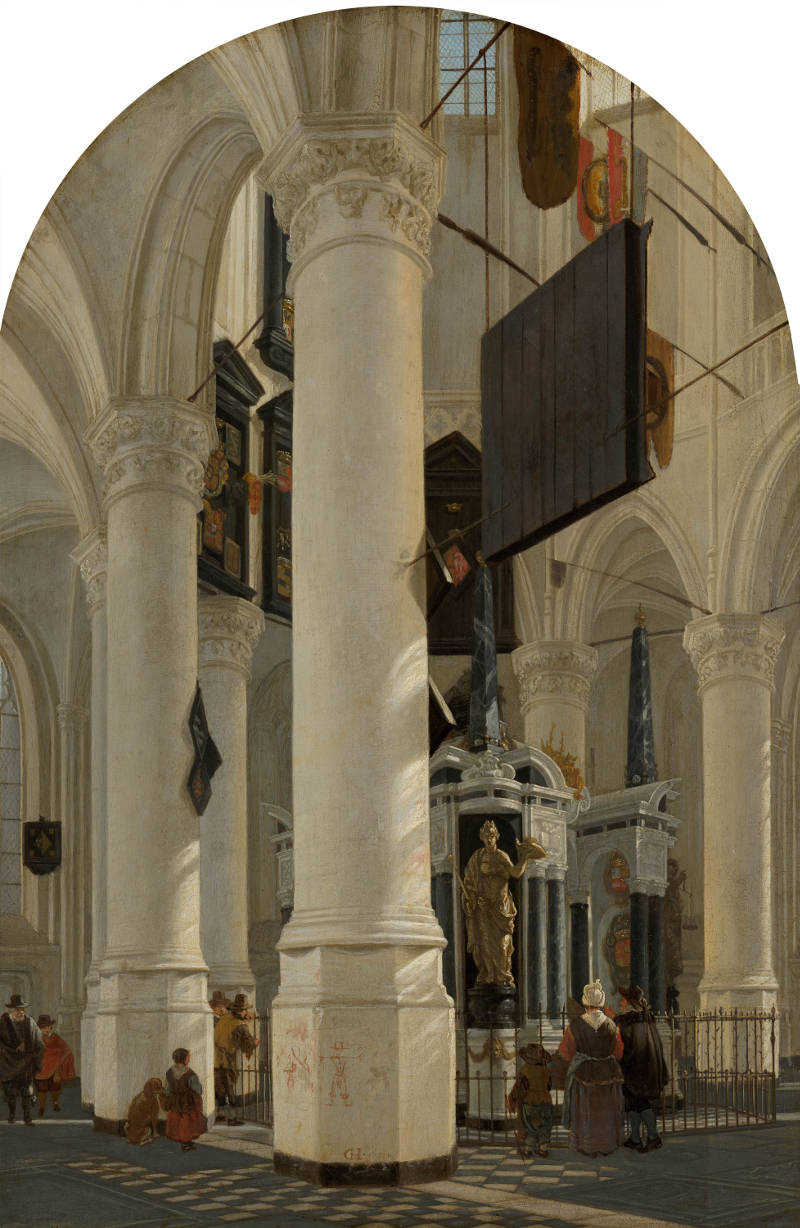
Gerard Houckgeest
1651
Oil on panel, 56 x 38 cm.
Mauritshuis, The Hague
Houckgeest's first known depiction of a real church interior is Interior of the Nieuwe Kerk, Delft, with the Tomb of William the Silent (fig. 2), dated 1650. Evidence suggests that his great panel was the first Delft picture of its kind. During the following years in Delft he painted about a half-dozen pictures of both the Oude and Nieuwe Kerk of Delft repeating the innovative diagonal perspective of the 1650 work. He married Helena van Comstrijen, a Delft woman from an influential family.
Along with Emanuel de Witte, Houckgeest is considered one of the greatest innovators of the Delft art scene. The two seemed to have developed an interest in architectural painting almost simultaneously. Houckgeest painted his scenes at oblique angles—as opposed to the traditional lengthwise or transverse viewpoint—lending his works a spontaneous, natural look. Like De Witte, Houckgeest was able to convey the most subtle nuances of daylight as it filters through glass windows high above and plays upon the austere architectural features of Delft's two historic churches. His views are often obscured by huge columns and pilasters in the foreground which gives spectators the sensation of being inside the church rather than outside looking in—a painted exercise in perspective.
Although no documentary evidence links the eccentric church painter Pieter Saenredam (1596–1665) to Houckgeest or De Witte, various art historians believe he may have inspired both. Saenredam visited Delft in March of 1651 to record the funeral procession of Prince Willem the Silent for the city of Haarlem. The church painters may have met on that occasion, but by then, Houckgeest and probably De Witte were already depicting the Delft churches in the new manner.
Emanuel de Witte
- born 1617–died 1692.
- active in Delft from c. 1641 to c. 1650.
Emanuel de Witte was born in Rotterdam and, at an early age, learned geometry from his father, a schoolmaster. He moved to Delft, only an hour by barge from Rotterdam, in 1640 and joined the local Guild of Saint Luke where he studied with the still life painter Evert van Aelst (1602–1657). Although it is believed that Emanuel de Witte (1617–1692) initially aspired to become a history and portrait painter, He is known to have painted a Rembrandt-like Holy Family. in about 1650 he abruptly changed artistic course and began to produce close-up interior views (fig. 3) of the two most venerable monuments of historic Delft, the Oude and the Nieuwe Kerk.
No one knows exactly why either De Witte or Houckgeest portrayed Delft churches so many times. If their intentions were to merely glorify Delft and the city's close ties to the House of Orange—Prince Willem II was buried in a magnificent tomb in the Nieuwe Kerk—it often appears that the attention of both artists was riveted by the play of light, the massive architectural components and the responses of the many anonymous individuals who came to visit these monuments.
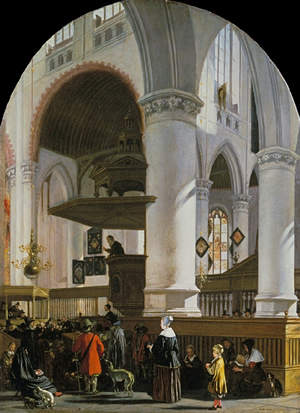
Emanuel de Witte
1651
Oil on oak panel, 60.5 x 44 cm.
Wallace Collection, London
Other than De Witte, few church painters have been able to portray, with such grace, daylight as it sifts down through the architectural features and plays delicately upon the surfaces of the walls, massive columns and decorative pavements. The intense naturalness of his works has induced critics to hold that De Witte's scenes must, to a certain degree, have been based on direct observation.
fig. 4 Interior of the Oude Kerk, Delft (detail)
Emanuel de Witte
c. 1650
Oil on wood, 48.3 x 34.6 cm.
Metropolitan Museum of Art, New York
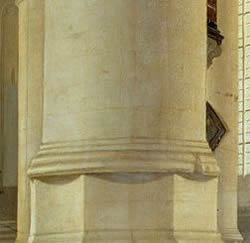 fig. 5 Interior of the Niuwe Kerk, Delft (detail)
fig. 5 Interior of the Niuwe Kerk, Delft (detail)Gerard Houckgeest
1650
Oil on panel, 125.7 x 89 cm.
Hamburger Kunsthalle, Hamburg
Emanuel de Witte's approach to church painting is more intuitive than Houckgeest's. His informal compositions pulse with life. Breaking from tradition, he relies less on the mechanics of linear perspective—one of the most highly valued artistic disciplines in seventeenth-century Netherlands—than on the subtle interplay of forms and color to suggest space and volume. Nonetheless, the spectator feels he is almost physically included amidst the massive architectural features of a real church rather than being located outside and looking in; into the hollow perspectives of earlier depictions of church interiors. The intangible qualities of De Witte's environments are said to have anticipated the optical approach of Vermeer.
Of all the artists of the School of Delft, De Witte and Vermeer were the painters most attentive to the planimetric layout of their paintings. The illusionist impact of their works is most successful when they are viewed from a distance. Viewed up close they appear oddly flat. For both painters, light is the means not only to create the illusion of space, volume and textures of the natural world, but abstract shapes and patterns on the canvas's surface that are in themselves of interest.
De Witte's palette was restricted to a range of silvery, diaphanous grays occasionally accented by a soft green or bright red. While the definition of the individual architectural feature is always secure, the contours of adjacent patches of carefully modulated tone softly blend into one another creating a sensation of light as it reverberates off the differently angled surfaces of stone and whitewashed walls (fig. 4). His brushwork is at all times confident. He avoided minute detail, a selling card for many of the Netherlands' most successful artists, which might detract from the overall impact of the image. His approach to painting can be said to be tonal, rather than chiaroscural. By comparison the modeling of Houckgeest (fig. 5) appears somewhat rigid.
WHAT IS TONAL PAINTING?
Due to the vagaries of the English language, "tone," in this particular context, is often a misunderstood word, particularly when used by artists and art historians. Tone simply refers to how light or dark a color appears to be. To accurately evaluate tone, one must temporarily ignore texture, shape, detail and even color as if looking at a black and white photograph without regard to its subject matter. Tonal painting differs from traditional chiaroscural painting principally in the treatment of shadows. In chiaroscuro, shadows are conceived essentially as the absence or negation of light. The broader shadows tend to be uniformly dark, and are habitually rendered by painters with a mixture of dark, neutral paint (black and raw umber were widely employed for this purpose) and small additions of the local color of the object being represented. By subjugating the specific character of shadows, Baroque painters were able to unify very complex and strongly colored compositions. Chiaroscural painting accentuates the sense of volume, but at a cost: space is perceived as a leftover vacuum.
On the other hand, in tonal painting shadows are treated positively, each one having a character of its own. The tonal painter pays more attention to specific tones and color (although never to the same degree as the lights) than the chiaroscural painter. When tonal values of the shadows are more accurately registered, as in De Witte's church interiors or in the outdoor scenes of the Impressionists, the viewer has the sensation that air circulates around objects, and that light is softer and more natural. De Witte, de Hooch and Vermeer were among those Dutch artists who were most attentive to the tone and color of shadows.
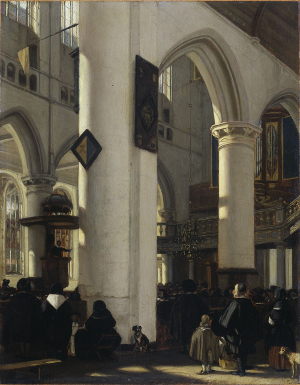
Emanuel de Witte
1669
Oil on panel, 44.5 x 33.5 cm.
Rijksmuseum, Amsterdam<
By 1652, De Witte had left Delft for Amsterdam where he remained for the rest of his life, at odds with his circumstances, sometimes living in deplorable conditions. Here, his first wife, Geerje Arents, died in 1655. He then married a 23-year-old orphan, Lysbeth van der Plas, who evidently had a negative influence on De Witte's adolescent daughter. In December 1659, both were arrested for theft from a neighbor. Following the arrest of his wife and child, De Witte was forced to indenture himself to the Amsterdam notary and art dealer Joris de Wijs, surrendering all of his work in exchange for room, board and 800 guilders annually. He painted many interior views of Amsterdam's principal churches (fig. 6), some highly contrasted market scenes and a few domestic interiors with one or two figures.
In the interior in A Lady Playing at the Virginal (fig. 7), he carefully elaborated a see-through view which again captures the sense of space characteristic of his outdoor market scenes and church interiors. This work, which shows a lady, seen from behind, seated at the virginal; her image reflected in a mirror above the instrument, has been often linked with Vermeer's Music Lesson.
The artist's gambling habit led to a figh with Gérard de Lairesse (1641–1711), the Dutch painter and art theorist. According to Arnold Houbraken (1660–1719), in 1692, after an argument about the rent, De Witte hung himself from a canal bridge. The rope broke and De Witte drowned. His corpse was not found until eleven weeks later. Perhaps due to his difficult life and severe bouts of depression, his work is uneven in quality although his best works are among the finest of the Golden Age of Dutch painting.
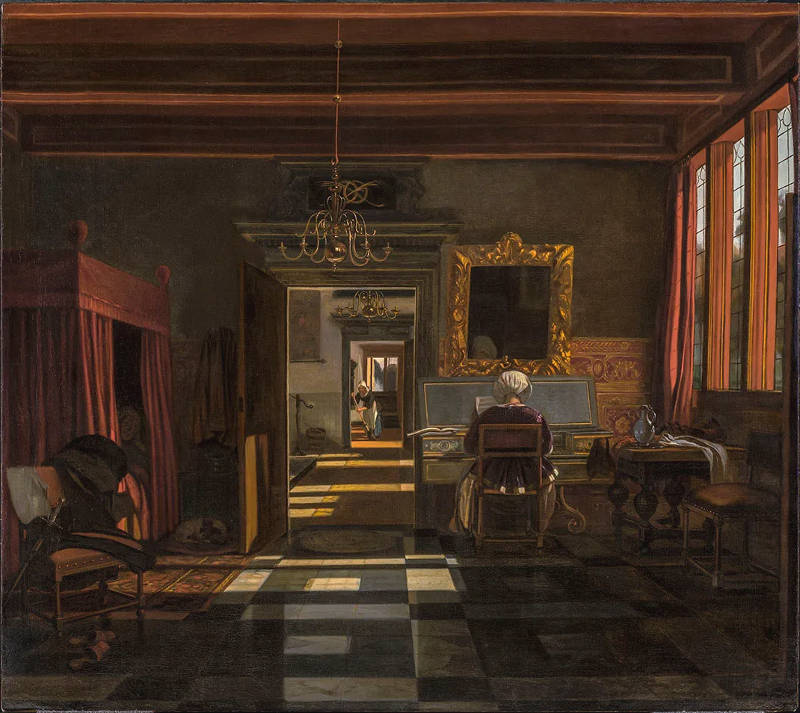
Emanuel de Witte
c. 1660-1667
Oil on canvas, 97.5 x 109.7 cm.
Montreal Museum of Fine Arts, Montreal